Reward Points Professional
Overview
In modern marketing, loyalty programs play an important role that can't be denied. Online stores put a lot of effort into keeping old customers and increasing sweet engagement scent between customers and stores. Hence, Mageplaza Reward points extension is developed to increase the interaction between customers and store owners to establish a great consumption cycle on your website.
Magento 2 Reward Points extension will allow earning unlimited reward points as well as using them flexibly as payment methods if necessary. By this way, it is not complicated to build a loyal customer network supplying the number of leads for the merchants.
The Reward Points system does not apply for guest customers.
The Product's Earning Point may vary according to a specific Customer Group and Earning Rate set in the backend.
Outstanding Features
| Pro | Outstanding Features | Description |
|---|---|---|
| 1 | Custom Point Earning Rules | Allow store owners to set up different rules and conditions for earning points. Customers can earn points from actions such as purchases. In addition, the module supports defining rules for earning points based on different criteria such as order value, product category, or customer group. These help store owners turn infrequent customers into loyal customers through an effective reward program. Customized Earning Rules: Admins can set up an exciting loyalty program with flexible reward points rules depending on the product, catalog or shopping cart rules that the customer adds. |
| 2 | Enhance customer experience in purchasing and using reward points | Customers can redeem points for discounts. The module provides options to configure point values and redemption thresholds. Spend sliders enhance the customer experience. By simply dragging the slider, customers can easily apply the desired amount of points to their purchases, making the checkout process faster and more convenient. Additionally, store owners can enable a one-click redemption option, allowing customers to easily use all their reward points at checkout. This streamlined functionality saves valuable time and enhances the overall customer experience, promoting a seamless and user-friendly interaction with the rewards program. Customized Spending Rules: Admins can set up a loyalty program by creating a rule to use reward points according to the shopping cart rule. Customers who use previously earned points will receive a custom discount. This encourages customers to use previously earned reward points to increase their purchase rate. |
| 3 | Optimize reward points management | Admins can manage, add and subtract customer reward points across multiple stores from a single admin dashboard. Admins can set expiration dates for reward points to encourage customers to use points promptly and maintain engagement. Additionally, sending automated emails to notify customers of earned points, upcoming expirations, and redemption opportunities will increase customer purchase rates. |
Installation Guide
We offer two methods for installing our plugins: the Copy & Paste method and the Composer method. Please follow the detailed instructions provided below.
Method 1: Installation via Copy & Paste
To install our plugins using the Copy & Paste method, kindly follow the instructions at the link below:
How to Install Magento 2 Extension via Copy & Paste
Method 2: Installation via Composer
Composer name: mageplaza/module-reward-points-pro
To install our extensions using Composer, please refer to the comprehensive guide at the link below:
How to Install Magento Extension via Composer
By following these guides, you can ensure that the installation process is handled correctly, allowing you to fully utilize the features and benefits of our plugins.
Module Update Guide
Keeping your module updated ensures optimal performance. Follow one of these steps to update your module:
- By Account Dashboard: Log in to your
Mageplaza account > go to the My Licenses section > click on the Download button > choose the latest version from the popup. - By composer: Kindly use the following commands to update the module via composer
composer require mageplaza/module-reward-points-pro
php bin/magento setup:upgrade
php bin/magento setup:di:compile
Updating a module by Composer ensures efficient dependency management, version control, and integration with development tools, making the process faster and more reliable.
Guide to install the library
Please run the below command to install the module library:
composer require liquid/liquid
How to use
I. For customers
- Earning Point(s) of the product can be depended on Customer Group, Earning Rate, Catalog Earning Rules, and Shopping Cart Earning Rules which are configured in the backend.
- Spending Point(s) customer use is depended on Spending Rate and Shopping Cart Spending Rule
Customers can earn reward point(s) and use them perfectly on the following pages:
1.1. The checkout page
- Customers can use their earned reward point(s) to discount the order.
- This page also displays the earning point(s) customers will receive when they place the order.

1.2. View Cart Page (Shopping Cart)
- This is familiar to the checkout page.
- However, Earning Point(s) can’t be shown on this page if admins disable the field Display Earning Points on Shopping Cart in the backend.
- Notice: Earning Point(s) can be different depend on Customer Group and Earning Rate which are configured in the backend.
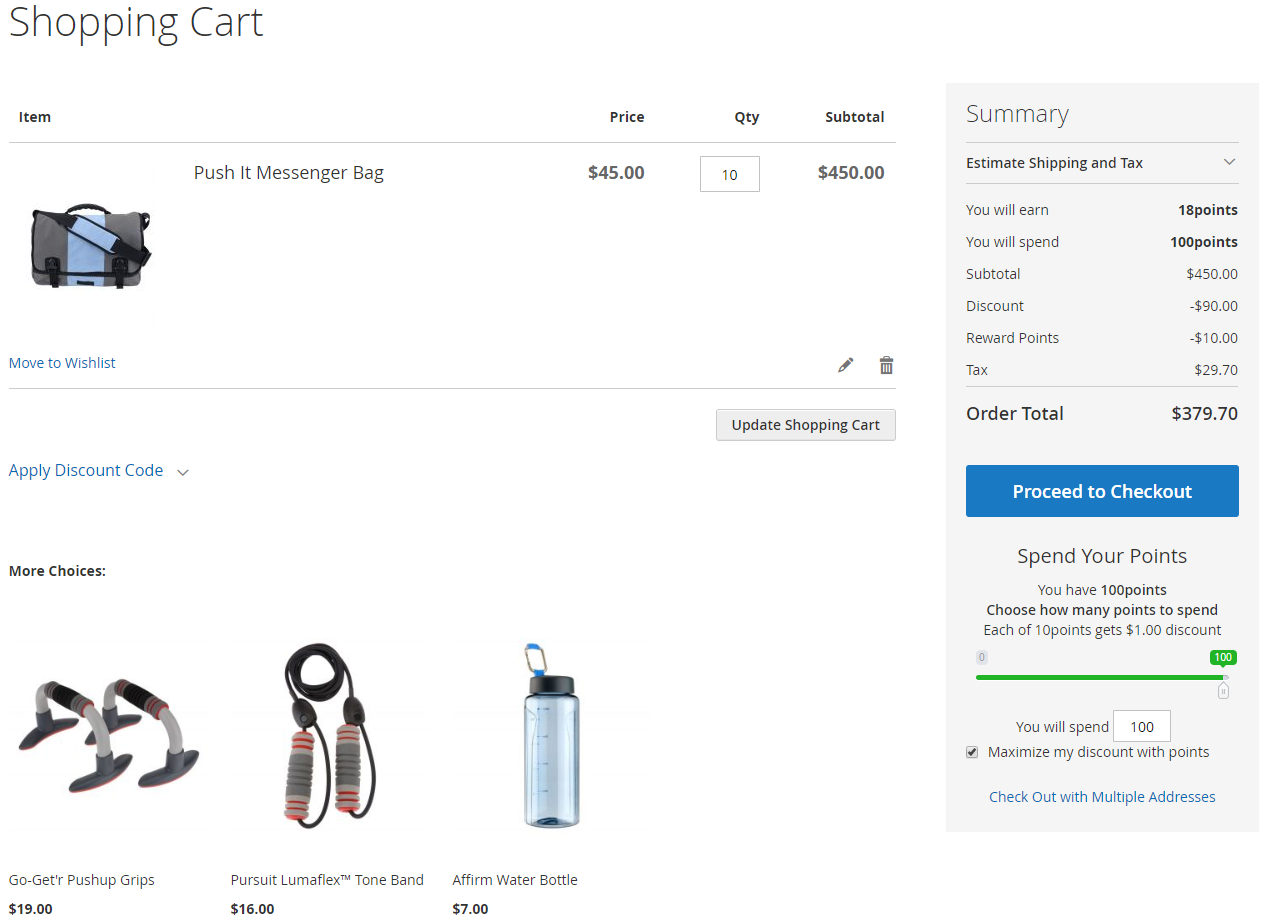
II. For admins (store owners)
- Admins are able to create and manage Earning Rate, Spending Rate and Transaction as well as to configure the Reward Points extension generally in the backend.
- Admins are able to apply changes to reward point(s) in the customer’s account in the backend.
- Admins are not supported to use reward point(s) when creating a new order at the moment.
How to configure
Log in to your backend, then go to Marketing > Reward Points and follow the instructions below to configure Reward Points extension
- Earning
- Spending
- Transactions
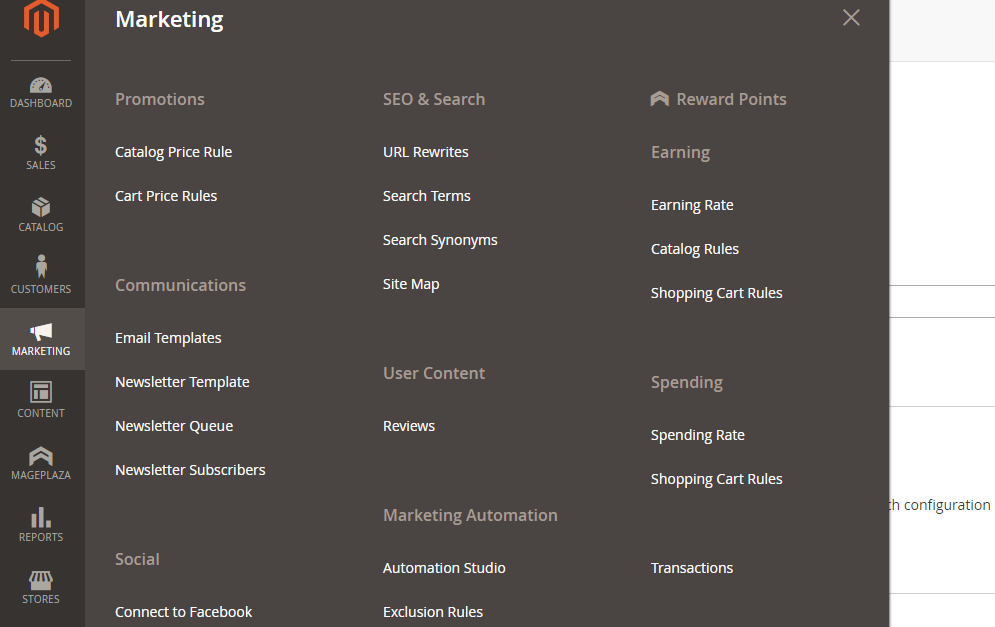
Earning rate and Spending Rate are stored in the same table inside the database. Therefore, the admin will probably see a slight difference in IDs of rates.

I. Earning
1.1. Earning Rate
Admins can set, check and edit customer point earning rates depending on the website or customer group. In addition, admins can set up point-earning rules based on product categories, and shopping cart rules. This helps store owners set up policies on point exchange rates to the corresponding amount of money to encourage customers to buy to receive more bonus points.
Go to Marketing > Reward Points: Earning Rate
1.1.1 General Management
This is the place where admins can store Earning Rates created.
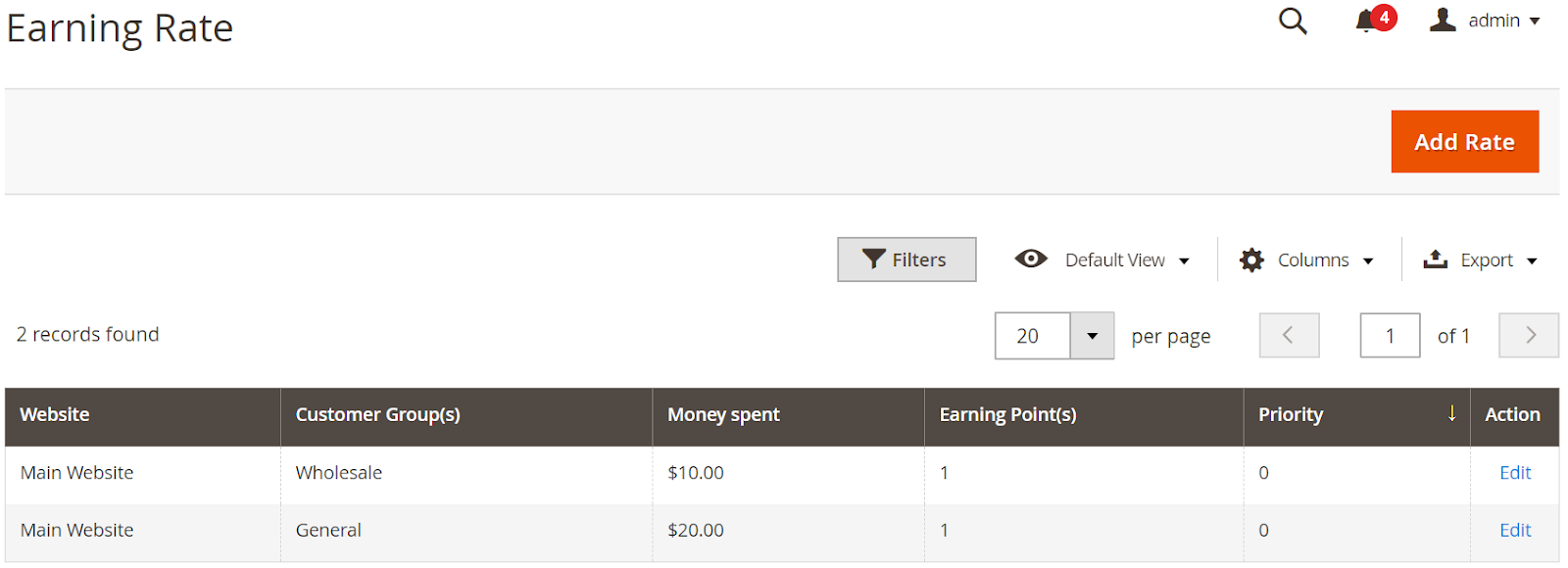
- From the grid view, admins can acknowledge some fundamental information of Earning Rate such as ID, Website, Customer Group, Money Spent, Earning Point and Priority. Also, admins are able to:
- Delete: Tick the checkbox of the earning rate they want to delete, then choose “Delete” in the
Actionbox (at the left of the grid). Choose “OK” in the confirmation message. - To edit an earning rate, choose “Edit” in the Action column.
- Delete: Tick the checkbox of the earning rate they want to delete, then choose “Delete” in the
- Admins can filter, hide or display Column or export rates.
1.1.2. Add/Edit New Earning Rate
After entering the Earning Rate section, click on Add New Rate to create a new earning rate. Then, click Save and Continue Edit, the page will automatically switch to the Edit Rate page.
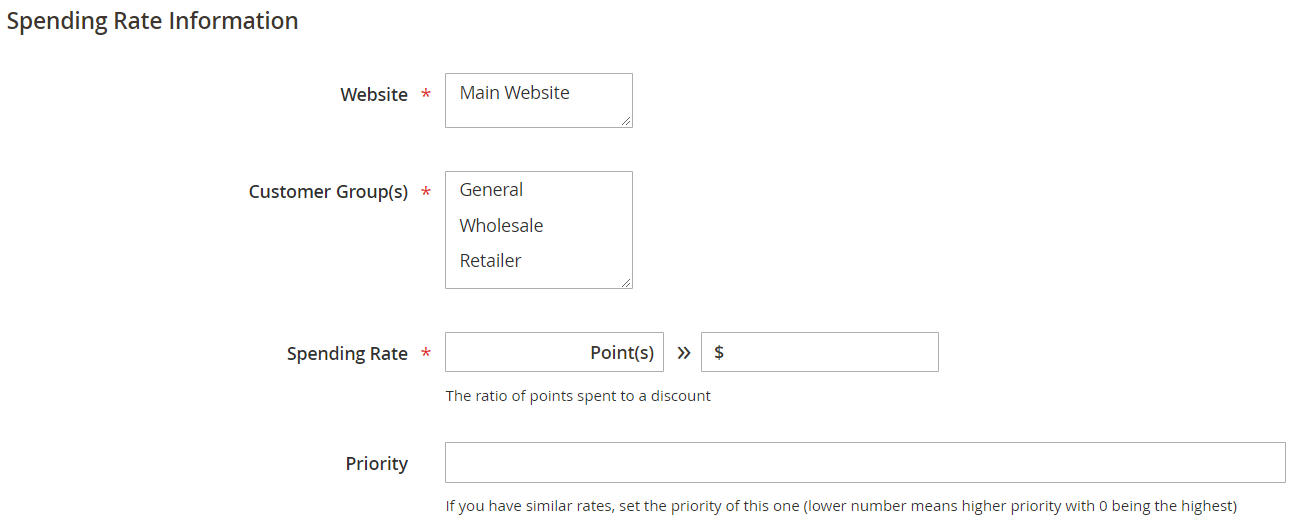
- In the Website field: Choose website(s) you want to apply the earning rate.
- In the Customer Group(s) field:
- Only customers who belong to this group can be entitled to this earning rate.
- Customers who belong to different groups can receive different earning rates even when they purchase the same product.
- In the Earning Rate field
- Define the conversion rate from X (currency) to Y (point)
- Admins can fill out the appropriate rate here. However, decimal numbers are not approved. If admins enter a decimal number, they will be rounded following the rule
>= 0.5 to 1, or< 0.5 to 0.
- In the Priority field:
- Indicates the priority of this spending rate compared to other spending rates.
- 0 indicates the highest priority. The higher number, the lower priority.
- If there are many earning rates that have similar priorities, rules will apply to the rate that has a smaller ID first.
1.2. Catalog Earning Rules
Admins can add new or edit Catalog Earning Rules in this section. Customers can receive points if they buy products that meet the conditions set in the Rule.
1.2.1. General Management
This is the place where admins can store the created Catalog Earning Rules.

- From the grid view, admins can acknowledge some fundamental information of a catalog earning rules such as ID, Name, Website, Customer Group, Status, Create On, Expired, and Priority.
- Admins can filter to search for a specific rule.
- After making some modifications to the rule, click
Apply Ruleto enable it immediately.
1.2.2. Add New Rule (Edit Rule)
- Admins choose
Add New Ruleat the right-above corner to create a new catalog rule, after clickingSave and Continue Edit, the page will be directed to the Edit Rate page - At the Add New Rule page, click on
Save and Applyto apply the new rule. - Add New Rule page has 3 tabs
- Rule Information
- Conditions
- Actions
1.2.2.1. Rule Information
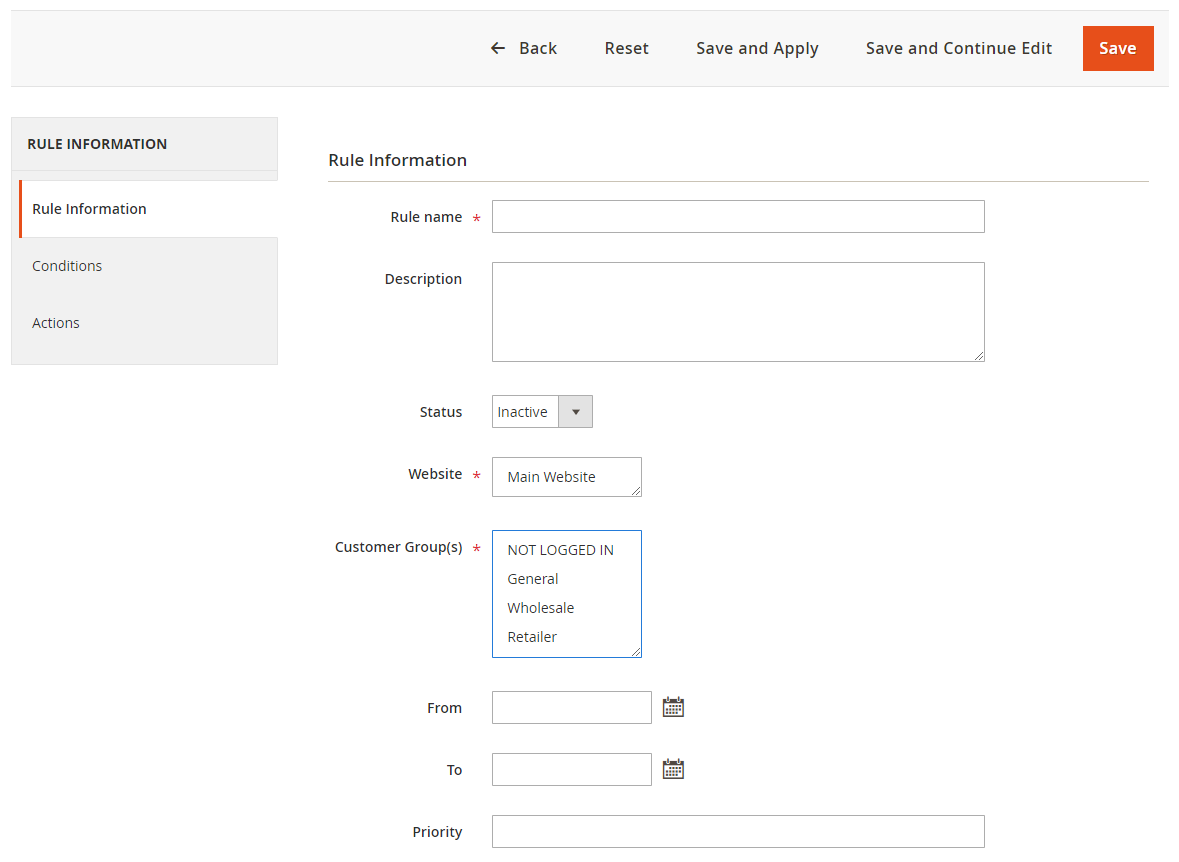
- In the Rule Name field
- Enter the rule name, which will be displayed in the backend.
- This is required information. There will be an error message if you leave it blank.
- In the Description field: You can note some rule descriptions. This field can be left blank.
- In the Status field: Choose "Active" to apply the rule.
- In the Website field: Choose website place(s) you want to apply the rule.
- In the Customer Group field:
- Choose group(s) of customer you want to apply for them.
- If the rule applies to Not Logged In customers, they still can learn earning point(s) of each product but point(s) won't be added unless they sign in or sign up on your store.
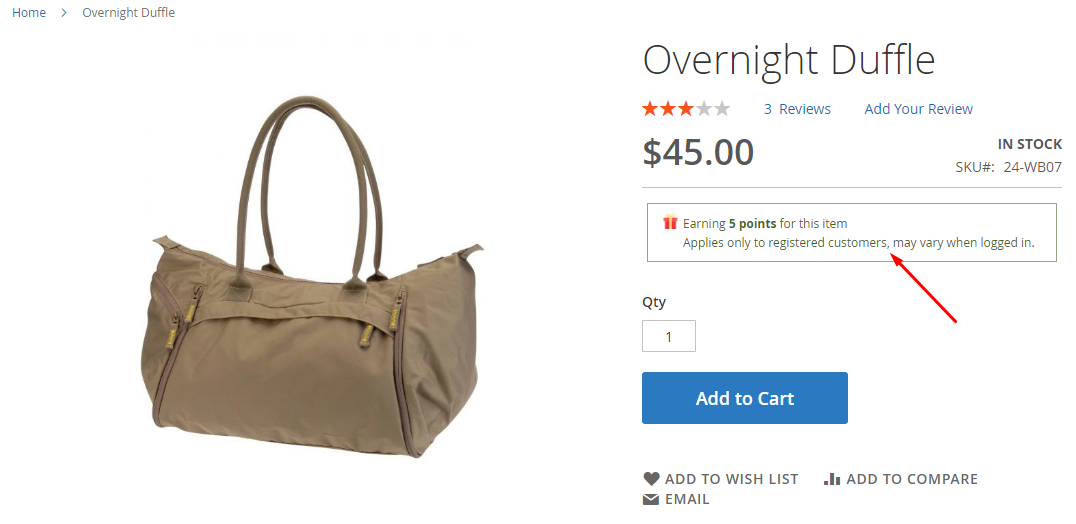
- In the From field: You can set up the start time to use the rule; please note the difference in time zones.
- In the To field: You can set up the end time to disable the rule.
- In the Priority field:
- Identifies the usage priority of this catalog earning Rule compared to others.
- 0 is the highest priority. The higher number represents the lower priority.
- If two catalog earning rules have the same priority, the rule with a smaller ID will be applied.
1.2.2.2. Conditions
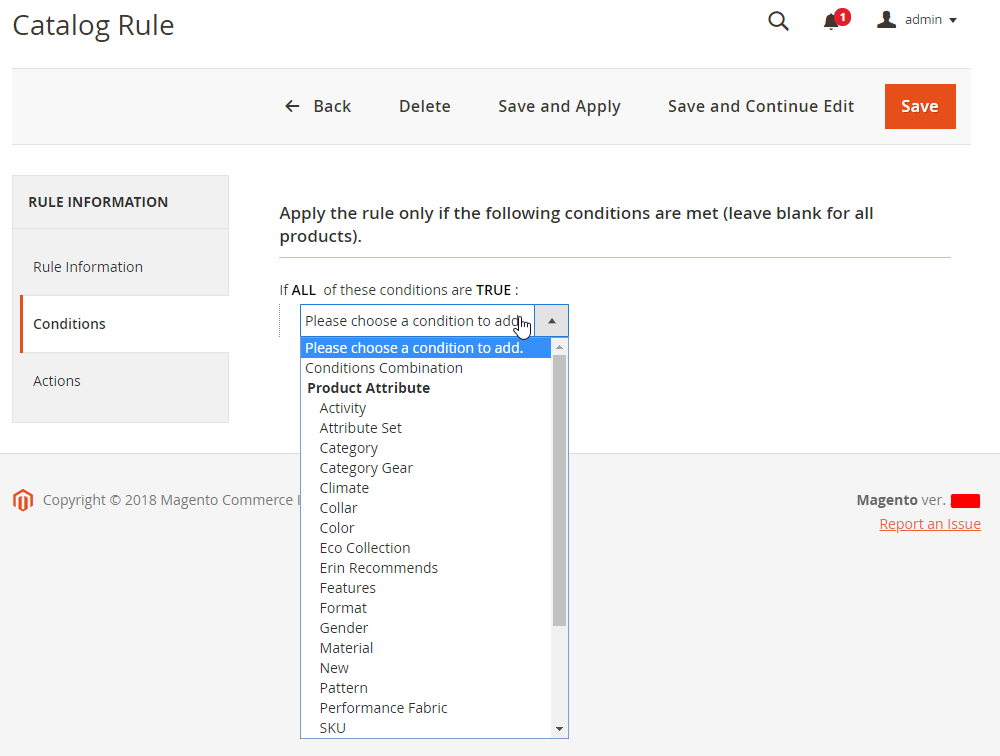
Choose a condition to apply the rule. Only Product pages that meet those conditions will be applied.
1.2.2.3. Action
Catalog Earning Rule includes 3 actions:
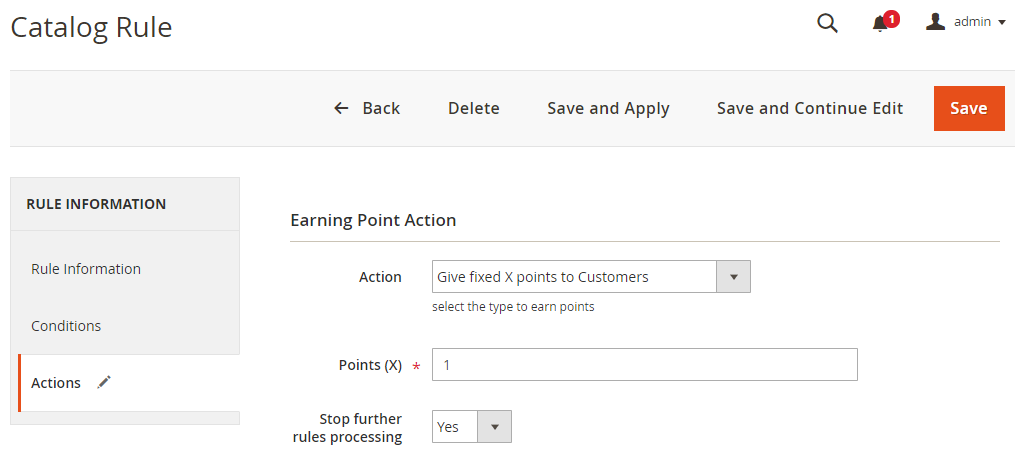
- Give fixed X points to Customers
- Customers will receive a fixed X point(s) for a product in their cart.
- In the Point X field: Enter fixed point(s) you want to set for customers.
- E.g: If Point X = 5, customer will receive 5 points per product they add to their cart. 2 items will be 10 points, no matter how pricing is.

- Give X points for every Y amount of Price
- The point(s) will be calculated based on product's Regular Price (on Special Price if the product has)
- In the Point X field: Enter X point(s) customer will receive for every Y amount of price.
- In the Money Step field: Enter the minimum Y amount so that customer can receive X points. Pricing will be rounded following
Rounding Methodof the configuration. - In the Maximum Earning Points field: Set the maximum earning point customer can get from this rule.
- E.g: Point (X) = 1, Money Step (Y) = 20, and Maximum Earning Point = 5 which mean
- When the customer purchases a product that costs $40, he will earn 2 points
- When the customer purchases a product that costs more than $100, he will only earn 5 points
- On the other hand, A product has Regular Price=$40, Special Price=$20, they will earn 1 point only

Give X points for every Y amount of Profit
- Some products that admins enter cost - as the price entered into that product. Profit is calculated by the sale price minus the cost. Action Give X points for every Y amount of Profit will transfer the difference to Point. If the product is not filled Cost, Profit is equal to Price.
- In the Point X field: Enter X point(s) the customer will receive for every Y amount of regular price (profit).
- In the Money Step Y field: Enter the minimum Y amount so that customer can receive X points. Pricing will be rounded following
Rounding Methodof the configuration - In the Maximum Earning Points field: Set the maximum earning point customer can get from this rule.
- E.g: Product A has Regular Price = $40, Special Price = 20$, cost = 25$, Point (X) = 1, Money Step (Y) = 20, and Maximum Earning Points = 5 which mean when the customer purchase Product A, point(s) will be based on (40$ - 25$ = 15$) and he will earn 1 points
Give points according to X% of original price

- Customers will get points according to X% of the original price, not based on the special price or the discounted price.
- Points (X): Enter the X% of the original price that customers can get points
- Maximum Earning Points: Enter the maximum Earning Points that customers can get based on this rule
- E.g: Product A has Original Price = $32, Special Price = 20$. When you set Points (x) = 10, Maximum Earning Points = 2, customers can get 32 x 10% = 3.2 point, however, because the Maximum Earning Points = 2, finally customer will only get 2 points.
- Stop further rule processing: Choose "Yes" to restrict the number of catalog earning rules applied to a product.
- E.g: Let's say there are 4 Cataloging Earning Rules created in turn, Rule 1, Rule 2, Rule 3, Rule 4, and priorities are 0, 5, 3, 3.
- All rules choose Stop further rules processing = No: 4 rules will be applied and points are accumulated. The customer will receive points from the summation of 4 rules.
- Rule 3 has Stop further rules processing = Yes: After applying, rule 1 will be applied (since it has higher priority) and rule 3. Rule 2 and 4 won't be applied because they have smaller priorities.
- E.g: Let's say there are 4 Cataloging Earning Rules created in turn, Rule 1, Rule 2, Rule 3, Rule 4, and priorities are 0, 5, 3, 3.
1.3. Shopping Cart Earning Rules
Admins can add new or edit Shopping Cart Earning Rules in this section. Customers can receive points if the shopping cart value meets the conditions set by admins.
1.3.1. General Management
This is the place where admins can store Shopping Cart Earning Rules created

- From the grid view, admins can acknowledge some fundamental information of a Shopping Cart Earning rule such as ID, Name, Status, Create On, Expired, and Priority.
- Admins can filter to search for a specific rule.
1.3.2. Add New Rule (Edit Rule)
- Admins choose
Add New Ruleat the right-above corner to create a new shopping cart earning rule, after clickingSave and Continue Edit, the page will be directed to the Edit Rate page - The Add New Rule page has 3 tabs
- Rule Information
- Conditions
- Actions
1.3.2.1. Rule Information
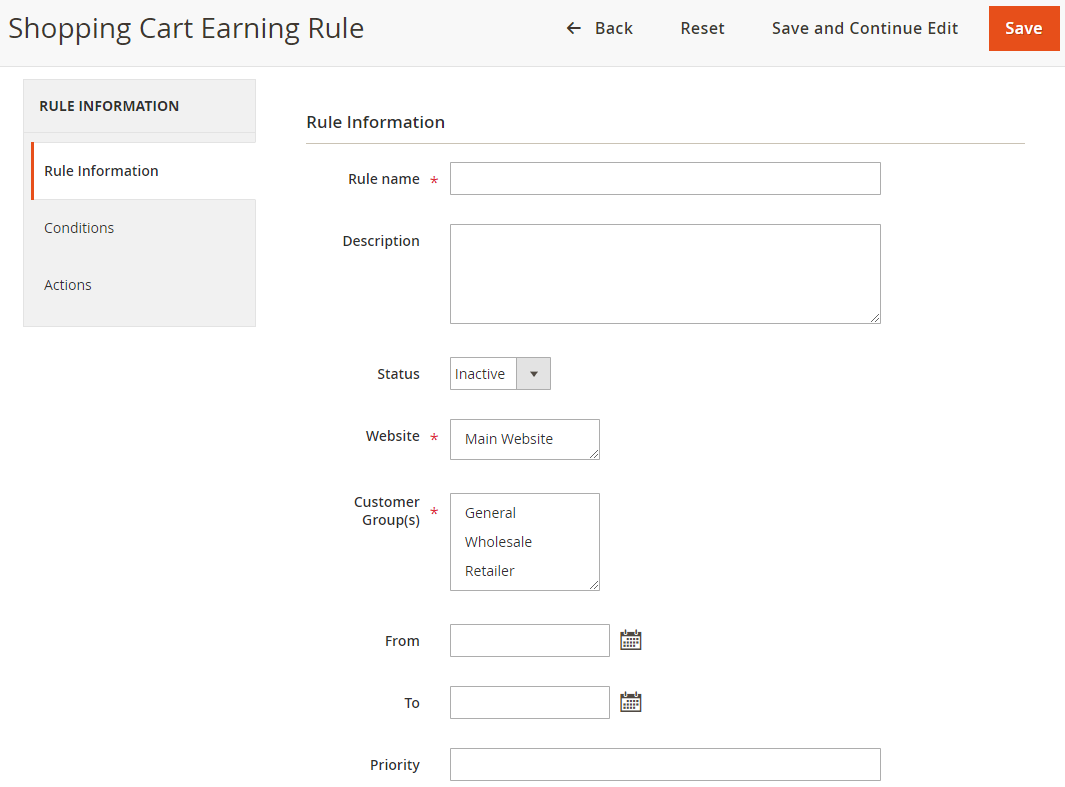
- In the Rule Name field
- Enter the rule name which will display in the backend.
- This is required information. There will be an error message if you leave it blank.
- In the Description field: You can note some descriptions of the rule. This field can be left blank.
- In the Status field: Choose "Active" to apply the rule.
- In the Website field: Choose website place(s) you want to apply the rule.
- In the Customer Group field:
- Choose group(s) of customer you want to apply for them.
- Shopping Cart Earning Rule doesn't apply to NOT LOGGED IN CUSTOMER.
- In the From field: You can set up the start time to use the rule; please note the difference in time zones.
- In the To field: You can set up the end time to disable the rule.
- In the Priority field:
- Identifies the usage priority of this shopping cart earning rule compared to others.
- 0 is the highest priority. The higher number represents the lower priority.
- If two shopping cart earning rules have the same priority, the rule with a smaller ID will be applied.
1.3.2.2. Conditions
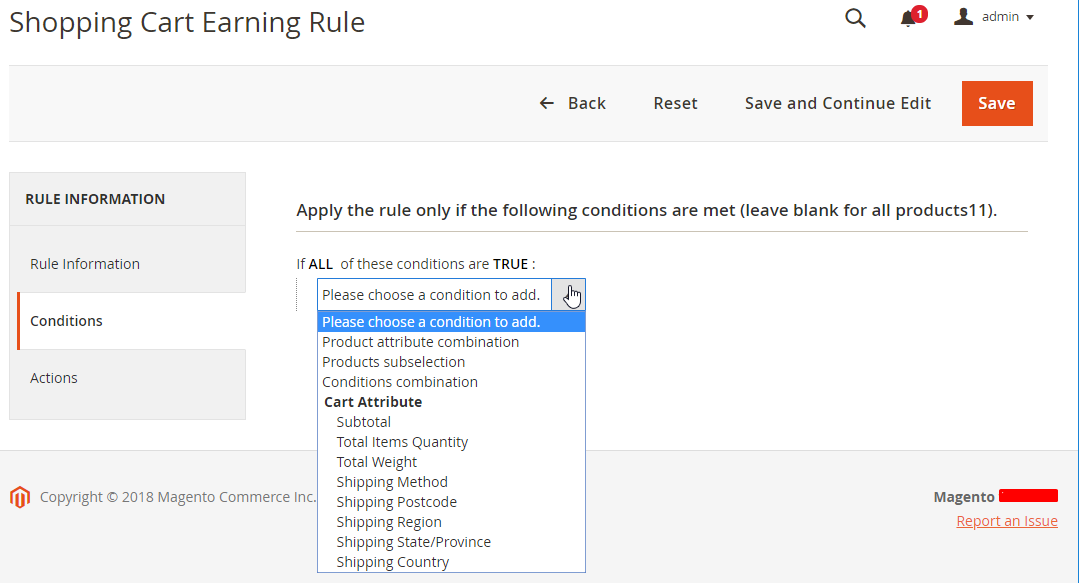
Choose a condition to apply the rule. Only the cart which meets those conditions will be applied.
1.3.2.3. Actions
Shopping Cart Earning Rule includes 3 actions:

- Give fixed X points for whole cart:
- Customer will receive a fixed amount of point(s) based on a purchased cart.
- In the Point (X) field: Enter point(s) customer can earn. This is the required field.
- E.x: Point (X) = 5 which means no matter how many products in the customer cart, they will only earn 5 points.

- Give X points for every Y amount of Price
- The point(s) will be calculated based on the cart's Subtotal
- In the Point X field: Enter X point(s) customer will earn for every Y amount of price.
- In the Money Step field: Enter the minimum Y amount so that customer can receive X points. Pricing will be rounded following
Rounding Methodof the configuration. - In the Maximum Earning Points field: Set the maximum earning points the customer can earn from this rule.
- E.g: Point (X) = 1, Money Step (Y) = 20, and Maximum Earning Point = 5 which mean
- When the customer purchases a cart which has Subtotal = $40, he will earn 2 points
- When the customer purchases a cart that has Subtotal of more than $100, he will earn only 5 points

- Give X points for every Y amount of Quantity:
- The point(s) will be calculated based on product's quantity
- In the Point (X) field: Enter X point(s) customer will earn for every Y quantity
- In the Money Step field: Enter the minimum Y amount so that customer can receive X points. Pricing will be rounded following
Rounding Methodof the configuration. - In the Maximum Earning Points field: Set the maximum earning point customer can earn from this rule.
- E.g: Point (X) = 5, Quantity Step (Y) = 1, and Maximum Earning Points = 5 which mean:
- When the customer place order a cart which has 6 products, he will earn 6 points.
- When the customer place order a cart which has more than 15 products, he will earn 5 points only.
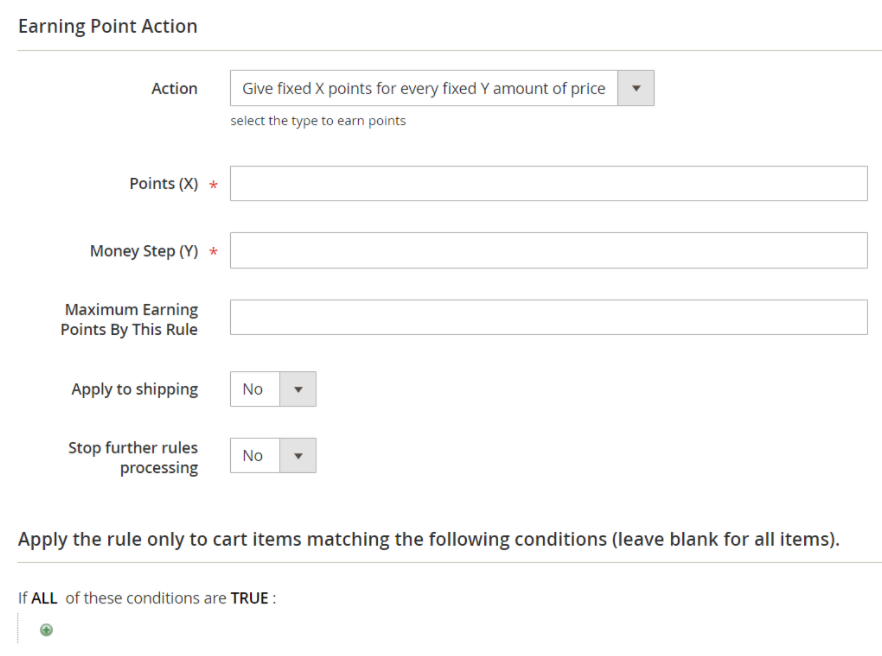
Give fixed X points for every fixed Y amount of Price:
- When the order value is from $Y (the Order Total will depend on the configuration of including Earn Points from Tax and Shipping or not), customers will earn fixed X points. And when the order value equals the multiples of $Y, the points will be multiplied accordingly.
- In the Point (X) field: Enter the fixed X point(s) customer will earn for every Y amount of order total.
- In the Money Step field: Enter the minimum Y amount so that customer can receive fixed X points for every Y amount of price. Pricing will be rounded following
Rounding Methodof the configuration. - In the Maximum Earning Points By This Rule field: Set the maximum earning points the customer can earn from this rule.
- E.g: Point (X) = 10, Money Step (Y) = 100, and Maximum Earning Points = 30 which mean:
- When the customer places an order that has the Order Total of $100, he will earn 10 points. If the Order Total is $120, he will still get only 10 points, and if the Order Total is from $200, he will earn 20 points, if the Order Total is from $300, he will earn 30 points, etc. The maximum point he can get is 30 points.
- Note: This Order Total takes into account the fact that you include Earn Points from Tax and Shipping. If you do not configure to include them, Order Total will exclude the tax and shipping fee from the total value for customers to earn points.
Stop further rule processing: Choose "Yes" to restrict the number of catalog earning rules applied to a product.
- E.g: Let's say there are 4 Cataloging Earning Rules created in turn, Rule 1, Rule 2, Rule 3, Rule 4, and priorities are 0, 5, 3, 3.
- All rules choose Stop further rules processing = No: 4 rules will be applied and points are accumulated. The customer will receive points from the summation of 4 rules.
- Rule 3 has Stop further rules processing = Yes: After applying, rule 1 will be applied (since it has higher priority) and rule 3. Rule 2 and 4 won't be applied because they have smaller priorities.
- E.g: Let's say there are 4 Cataloging Earning Rules created in turn, Rule 1, Rule 2, Rule 3, Rule 4, and priorities are 0, 5, 3, 3.
Apply the rule only to cart items matching the following conditions (leave blank for all items)

Only when product(s) in the cart meet these conditions, the rule will be applied.
II. Spending
Follow the way Marketing > Reward Points: Spending Rate
2.1. Spending Rate
Admins can set, check, and edit customer point usage rates depending on the website or customer group. This helps store owners set up policies on point usage rates corresponding to the appropriate amount to increase sales without affecting store revenue.
2.1.1. General Management.
This is the place where admins can store Spending Rates created.

- From the grid view, admins can acknowledge some fundamental information of a spending rate such as ID, Website, Customer Group, Spending Point, Discount Received, and Priority. Also, admins can:
- Delete: Tick the checkbox of the spending rate they want to delete, then choose “Delete” in the
Actionbox (at the left of the grid). Choose “OK” in the confirmation message. - To edit a spending rate, choose “Edit” in the Action column.
- Delete: Tick the checkbox of the spending rate they want to delete, then choose “Delete” in the
- Admins can filter, hide or display Column or export rates.
2.1.2 Add/Edit New Spending Rate.
After entering the Spending Rate interface, select Add New Rate to create a new spending rate. Then, click Save and Continue Edit, the page will automatically switch to the Edit Rate page.
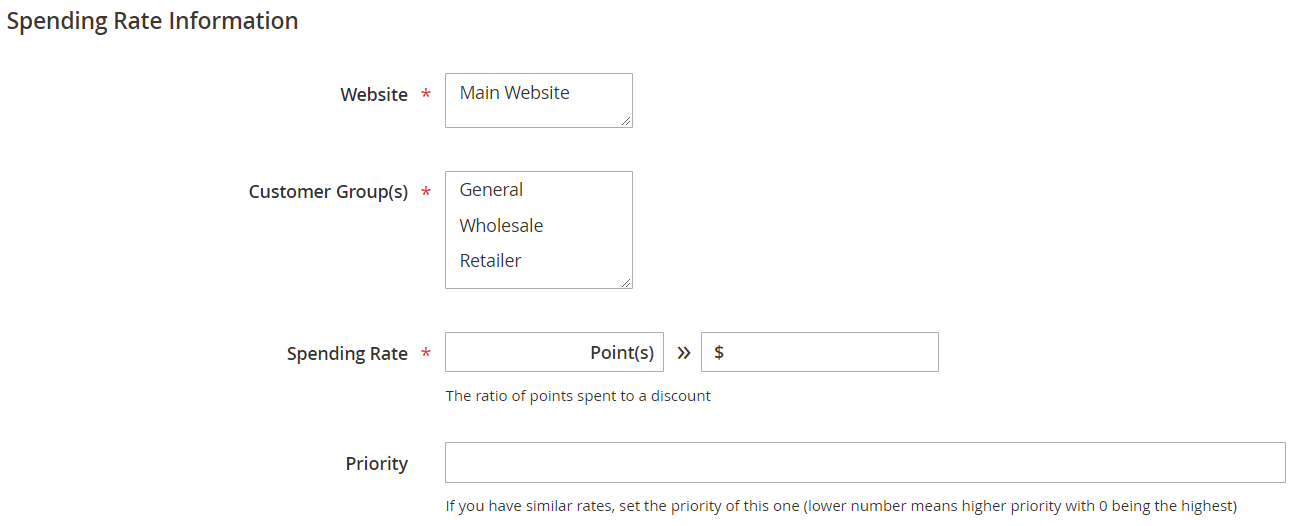
- In the Website field: Choose website(s) you want to apply the spending rate.
- In Customer Group(s) field
- Only customers who belong to this group can use their point(s) following this spending rate.
- Customers who belong to different groups use different spending rates even when they purchase the same product.
- In Spending Rate field
- Indicates the conversion rate from X (point) to Y (currency)
- Admins can fill out an appropriate rate here. However, decimal numbers are not approved. If admins enter a decimal number, they will be rounded following the rule
>= 0.5 to 1, or< 0.5 to 0.
- In Min Point: set the minimum number of points that can be spent when order
- In Priority field
- Indicates the priority of this earning rate compared to other earning rates.
- 0 indicates the highest priority. The higher number, the lower priority.
- If there are many spending rates that have similar priorities, rules will apply to the rate that has a smaller ID.
2.2. Shopping Cart Spending Rule
Admins can add new or edit Shopping Cart Spending Rules in this section. Customers can receive discounts if they use the points they have earned. The percentage or amount of discount is suitable for the conditions set by the admin. This encourages customers to interact with the store and use the points earned for new orders to boost store sales.
2.2.1. General Management
This is the place where admins can save all Shopping Cart Spending rules.
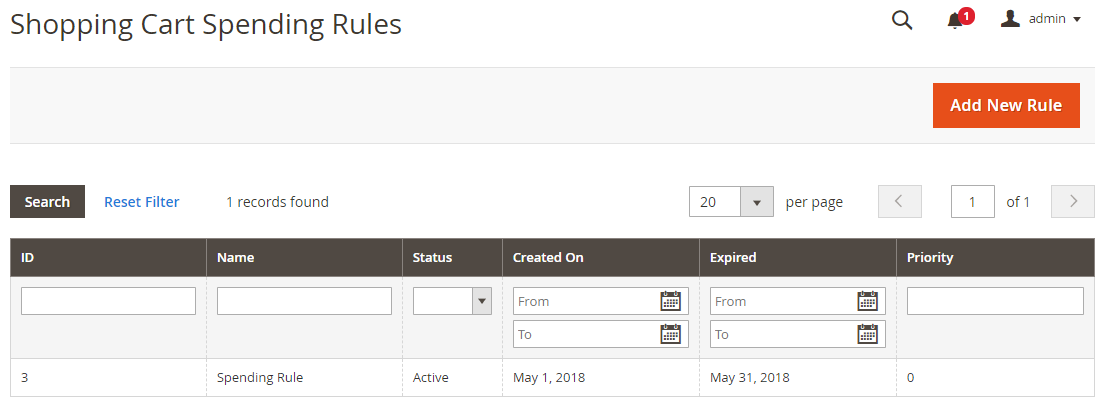
- From the grid view, admins can acknowledge some fundamental information of a Shopping Cart Spending Rule such as ID, Name, Status, Create On, Expired, and Priority.
- Admins can filter to search for a specific rule.
2.2.2. Add New Rule (Edit Rule)
- Admins choose
Add New Ruleat the right-above corner to create a new shopping cart earning rule, after clickingSave and Continue Edit, the page will be directed to the Edit Rate page - The Add New Rule page has 4 tabs
- Rule Information
- Conditions
- Actions
- Labels
2.2.2.1. Rule Information
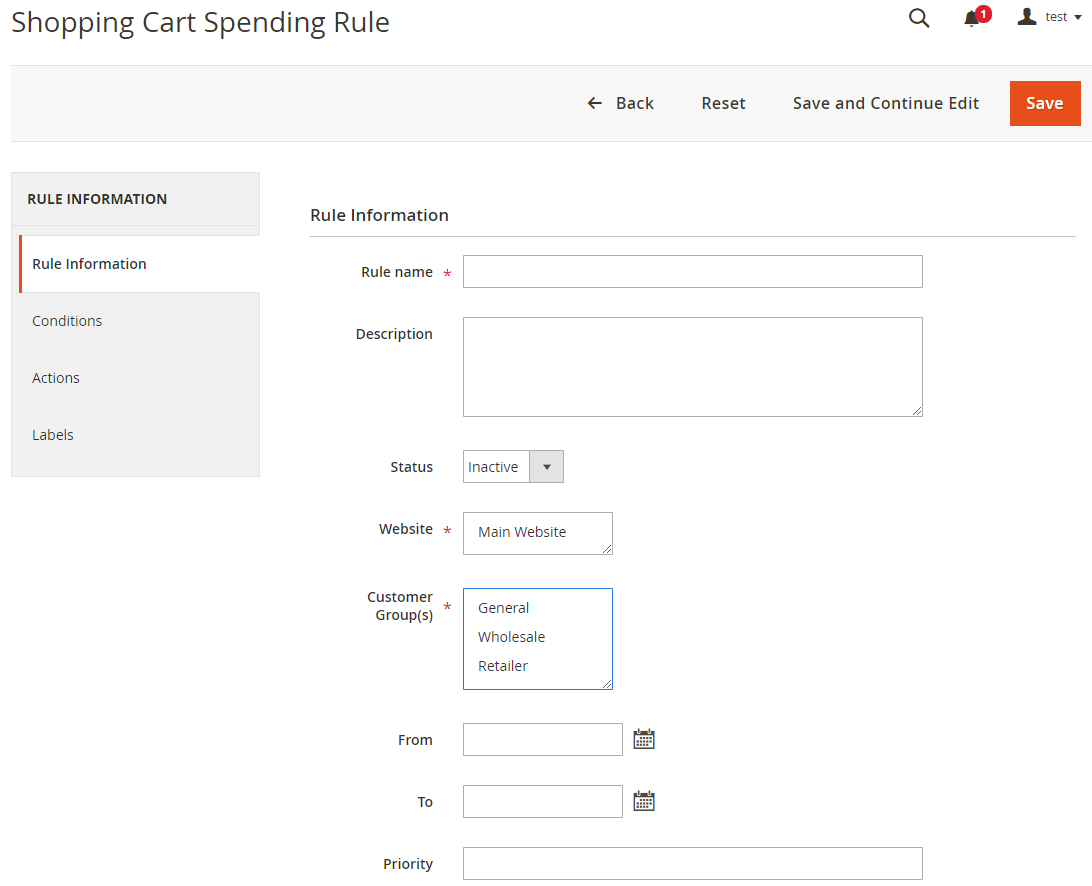
- In the Rule Name field
- Enter the rule name which will display in the backend to distinguish with other rules
- This is required information. There will be an error message if you leave it blank.
- In the Description field: You can note some descriptions of the rule. This field can be left blank.
- In the Status field: Choose "Active" to apply the rule.
- In the Website field: Choose website place(s) you want to apply the rule.
- In the Customer Group field:
- Choose group(s) of customer you want to apply for them.
- Shopping Cart Spending Rule doesn't apply to NOT LOGGED IN CUSTOMER.
- In the From field: You can set up the start time to use the rule; please note the difference in time zones.
- In the To field: You can set up the end time to disable the rule.
- In the Priority field:
- Identifies the usage priority of this shopping cart spending rule compared to others.
- 0 is the highest priority. The higher number represents the lower priority.
- If two shopping cart spending rules have the same priority, the rule with a smaller ID will be applied first.
2.2.2.2. Conditions
Conditions of Shopping Cart Spending Rule is divided into 2 parts:
- Conditions: Only the cart that meets the chosen conditions can be applied.
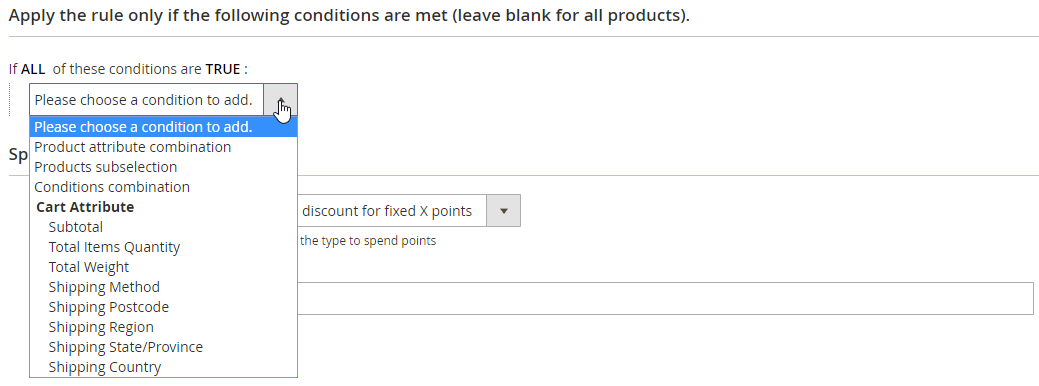
- Spending Point Action:
- In the Action field: There're 2 options:
- Give discount for fixed X points: Customers can spend a fixed point(s) that admin set in this section.
- Give a discount for every X points: Customer can spend point(s) to use X points to get a discount for every Y amount (Y will be set up in the Action tab). The applicable X points cannot be exceeded Maximum Redeemable Points.
- In the X Point field: Enter the number of point(s) you want to set for the above conditions.
- In the Action field: There're 2 options:

2.2.2.3. Actions
Admins configure Discount Amount corresponding to X Point which is set in the Conditions tab. There's 2 types of action:
- Give a fixed discount amount for the whole cart: Discount Amount is set fixedly for every X point(s).

- Give a percent discount amount for the whole cart: Discount Amount is calculated based on percent of Order Total.

- E.x: Discount Amount = 10 in the Action tab. In Conditions tab, choose
Action = Give discount for every X pointsand X = 1. When a customer places an order which costs $500:- The customer will be discounted $10 for every 1 point spending if in the backend, the admin chooses
Action = Give a fixed discount amount for the whole cart. Particularly, he spends 1 point and only needs to pay $490 for the order (which hasn't been included Shipping Fee and Tax). - The customer will be discounted 10% for every 1 point spending if in the backend, the admin chooses
Action = Give a percent discount amount for the whole cart. Particularly, he spends 1 point and only needs to pay $450 for the order (which hasn't been included Shipping Fee and Tax)
- The customer will be discounted $10 for every 1 point spending if in the backend, the admin chooses
Besides, admins can configure more conditions to apply the rule properly.

2.2.2.4. Labels
This is where admins configure the label for the rule in every Store View of a store. If it's left blank, the default label will be displayed on the frontend.

III. Transactions.
Admins can manage and check customers' point earning or point usage transactions. In addition, they can add or subtract bonus points according to each customer's situation.
The right path is Marketing > Reward Points: Transaction.
3.1. General Management.
This is the place where admins can create and manage transactions. By entering this interface, admins can add/minus customer’s reward point(s).
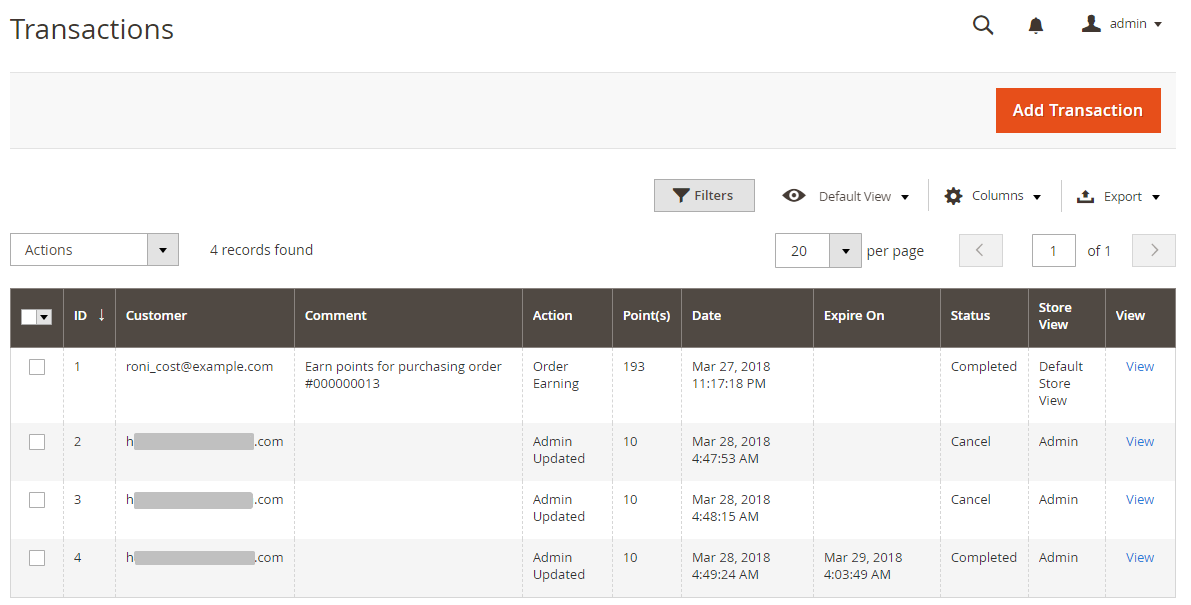
- From the grid view, admins can acknowledge some fundamental information of created transactions such as ID, Customer, Action, Point(s), Expire On, Date, Status. Also, admins can:
- View: To review a transaction, choose “View” in the Action column.
- Cancel: To cancel a created transaction (in case its expiration date hasn’t come yet), select the transaction and choose “Cancel” in the Action box (at the left of the grid).
- Expired: Admins need to take this action if a transaction isn’t expired automatically. At this point, take the same action when admins view/cancel a transaction, choose “Expired” then process with the
OKbutton.
- Admins can filter, hide/display Column or export rates.
3.2. Add new transaction.
After entering Transaction tab, choose Add new transaction to generate a new transaction. Next, click Save and Continue Edit; the page will direct you to the View Rate page.
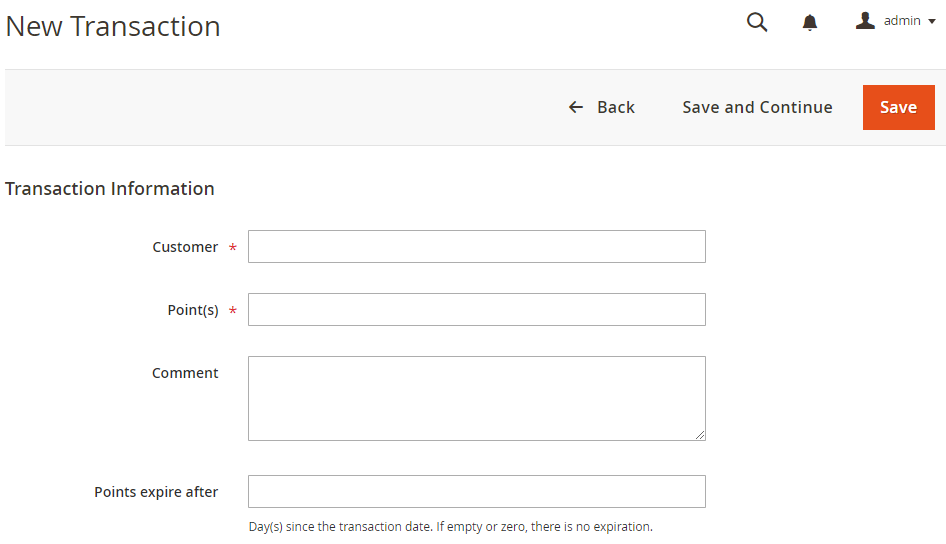
- In the Customer field
- Click this section to display the store’s customer list in the popup form. Admins can only choose 1 from this customer list.
- Name of the chosen customer will be added reward point(s) to her/his account.
- If you leave this field blank, there will be an error message.
- In the Points field
- Enter the number of point(s) you want to add for the chosen customer.
- If you enter negative numbers or leave it blank, there will be an error message.
- If you enter a decimal number, it will be rounded down (E.x: 1.8 = 1.1 = 1)
- In the Comment field
- Enter the comment that will be sent along with the added point(s) to the chosen customer.
- You can leave this field blank.
- In the Points expire after field
- The added point(s) of this transaction will expire after X day(s) from the time you create this transaction.
- Admins have the right to add higher point(s) than the maximum point of the amount that a customer can accumulate (E.x: max point = 1000, admins can add 1100 points or even more to the customer balance).
3.3. View Transaction.
Admins can review or expire a transaction on the View Transaction page.
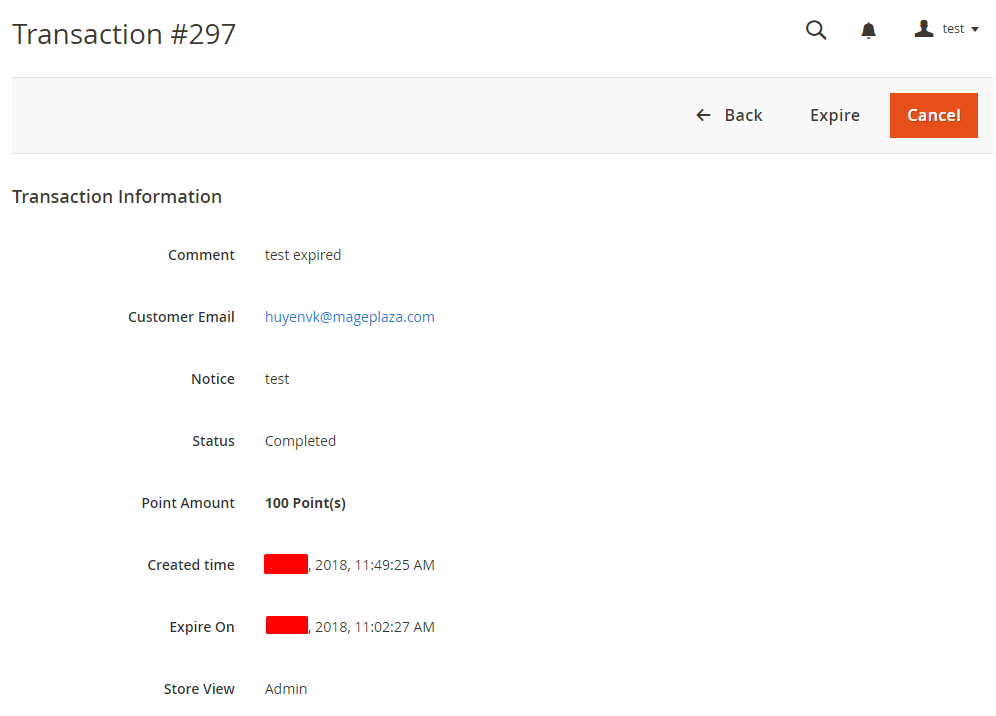
IV. Configuration
In this section, admins can enable or disable the module, set conditions for earning and using points, as well as set up email notifications about point changes and bonus point expiration dates.
Follow in the backend Store > Settings > Configuration. At the left panel, choose Mageplaza > Reward Points
4.1. General Configuration.
This general configuration can apply to the whole module.

In the Enable field: Choose “Yes” to activate the Reward Point extension from Mageplaza.
In the Label in My Account Navigation field: Enter the name of Tab Reward Point displayed on the frontend at the My Account > Reward Point section.
In the Point Label field:
- This label will be displayed on the frontend.
- If you leave it blank, there will be an error message.
In the Plural Point Label field:
- If the balance is greater than 1, this label will be displayed on the frontend.
- If you leave it blank, there will be an error message.
In the Display Point Label field:
- Select After Amount to display the point label after number (ex: 5 points).
- Select Before Amount to display the number label before number (ex: points 5).
In the Zero Point Label field:
- Enter the label when the customer's account balance is equal to 0.
- If you leave it blank, there will be an error message.
In the Show Point Icon field: Choose “Yes” to display the point icon on the frontend.
In the Reward Point Icon field:
- The upload image will be used as the point icon and be shown on the frontend.
- JPG, PNG or GIF files are accepted. There will be an error message if the input file is invalid.
- If you leave it blank, the default icon will be used
 .
.
In the Highlight Point on Storefront field:
- Show in Cart: Choose Yes to enable highlight poitn in Shopping Cart page > summary cart
- Show on Checkout Page: Choose Yes to enable highlight poitn in Checkout page
- Show on Product Pages: Choose Yes to enable highlight poitn in Product Detail page
- Show on Categories Pages: Choose Yes to enable highlight poitn in Category page
- Show highlight for Guests: Choose Yes to enable highlight poitn in for non-login customers
- Text Color: Choose the color for the highlight point
In the Maximum Available Point Balance field
- Set the maximum number of point(s) that the customer can accumulate by purchasing.
- If customer's account balance reaches this number, there will be no more points awarded to the balance, and reward point(s) indicators will not be shown on the frontend.
- Admins can add point(s) to an account balance with no awareness of this value.
- If the field is left blank or 0, there will be no restriction for the maximum points
In Redirect to My Points and Rewards page after customer login account field: Select Yes to redirect customers to My Points and Rewards page right after customer logs in or creates an account.
Landing Page

- Choose Landing Page: Select the page to show when clicking on the Landing Page link.

- Display Landing Page On Footer Link: Select Yes to show Landing Page Link in the Footer.
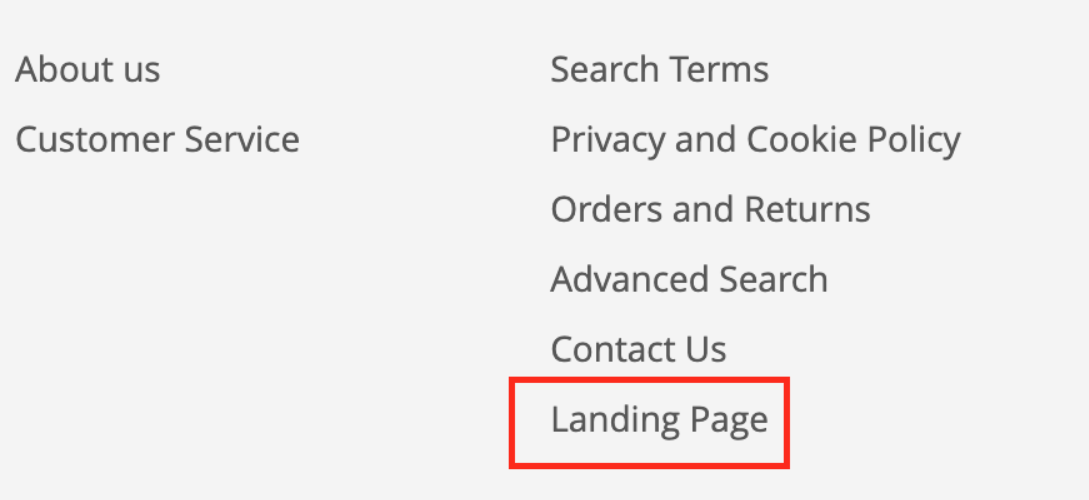
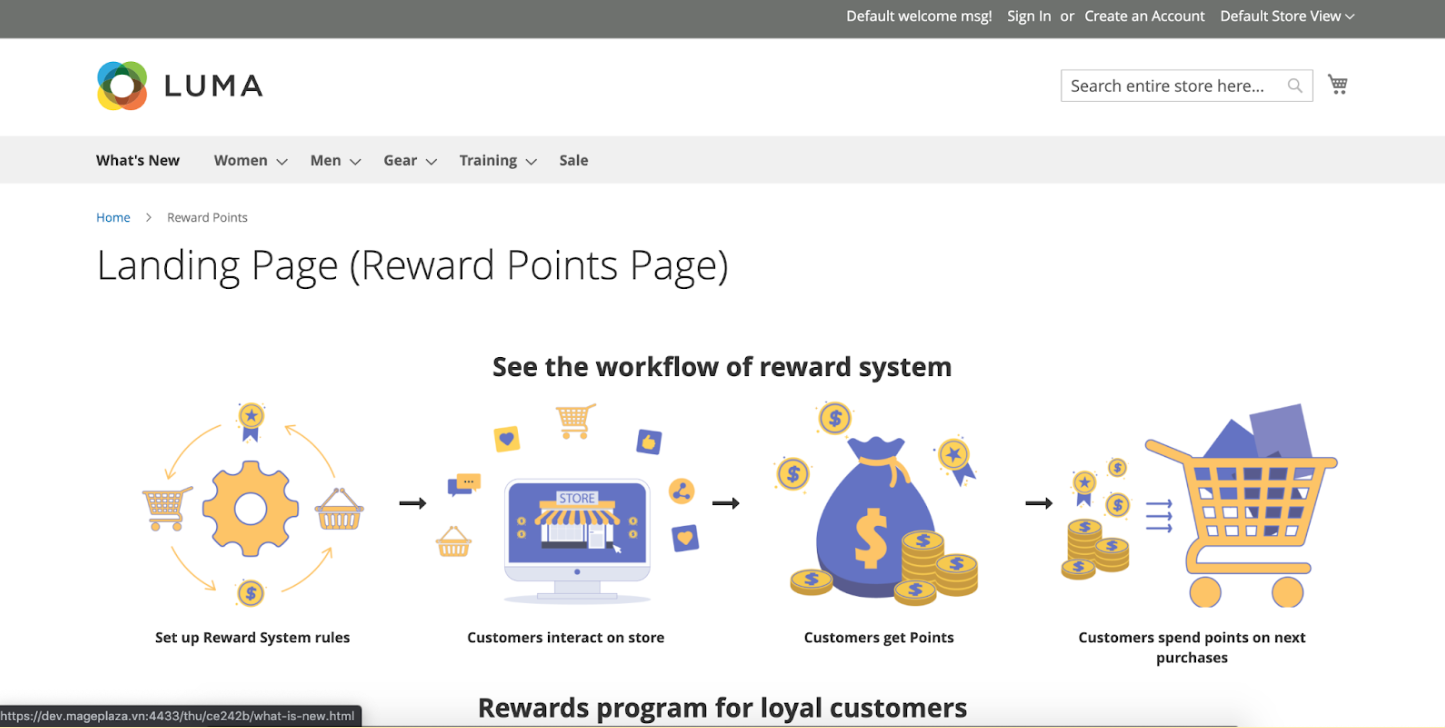
- Landing Page Label: Enter the label to show Landing Page link in the Footer.
4.2. Earning Configuration.
In this section, admins can set up rules for earning points from taxes or limit the maximum amount of points that customers can earn, the time customers can receive bonus points or the expiration time of bonus points. This helps admins manage and create appropriate policies for providing bonus points to customers.
4.2.1. General
This displays general configurations regarding earning point(s)
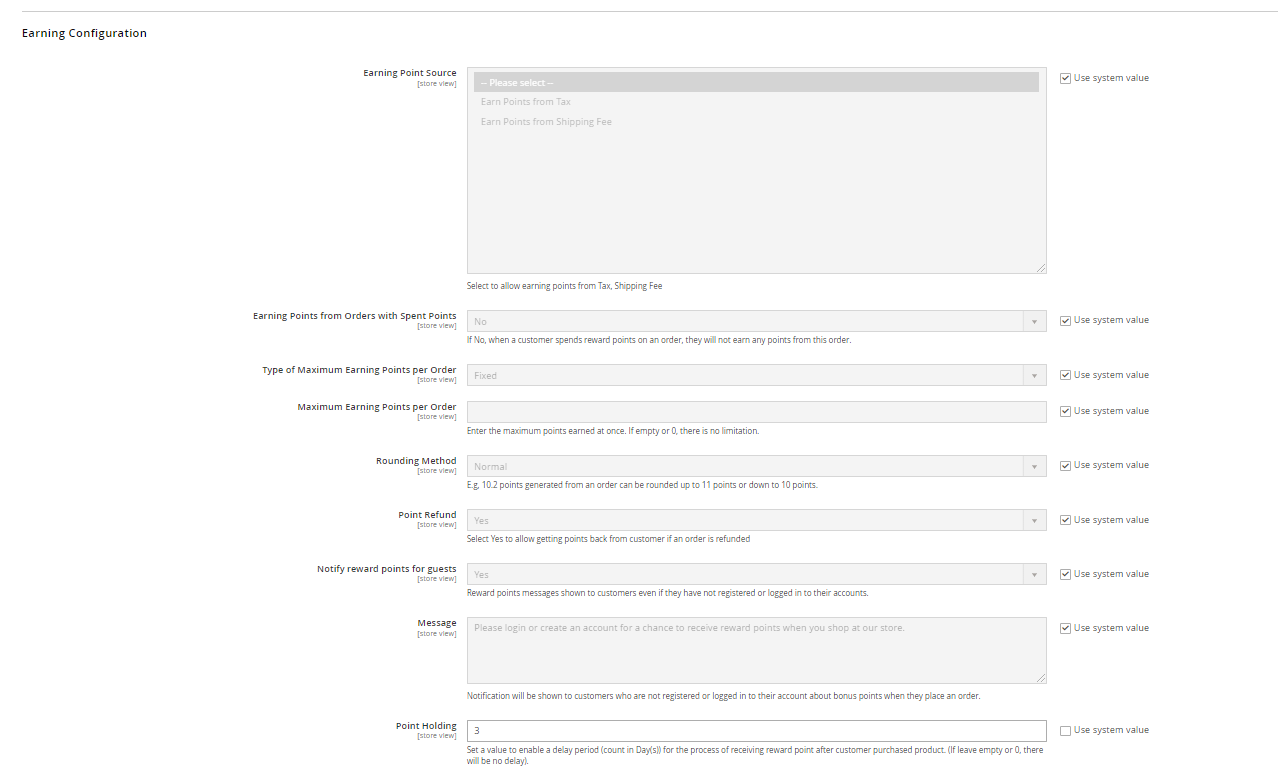
In the Earning Point Source field: There are 2 options:
- In the Points Earning From Tax field: Select “Yes” so the tax can be converted to earning point(s)
- In the Earn points from shipping fee field: Select “Yes” to allow Shipping Fee to be converted to point(s).
In the Earning Points from Orders with Spent Points: Select Yes so that when customers spend points on an order, they still can earn points from that order.
In the Type of Maximum Earning Points per Order: Choose how to calculate the maximum allowed points for each order. There are 2 types:
- Fixed: Set the maximum allowed points as a fixed value set in the Maximum Earning Points per Order field.
- Percent: Set the maximum allowed points as a percentage of the cart set in the Maximum Earning Points per Order field.
Maximum Earning Points per Order: Set the maximum allowed points customers can get for each order. If left empty or 0, the maximum point is unlimited.
In the Rounding Method field: There are 3 options for rounding
- Normal: The number of points converted from the currency (USD, EUR, ...) will be rounded according to the normal rule. E.x: 10.2 rounded to 10; 10.8 rounded to 11.
- Rounding Up: The number of points converted from the currency (USD, EUR, ...) will be rounded up. E.x: 10.2 or 10.8 is rounded to 11.
- Rounding Down: The number of points converted from the currency (USD, EUR, ...) will be rounded down. Ex: 10.2 or 10.8 is rounded to 10.
In the Point Refund field: When the customer places an order, they will receive a certain amount of earning points. The shop owner selects “Yes” in this section to retrieve the points when the customer refunds the order.
In the Notify reward points for guests: Select Yes to notify customers when they have not registered or logged in to their accounts.
- Message: Enter messages to show customers on frontend.

In the Point Holding field:
- Set the number of days delay that customers need to wait to receive points after purchasing
- If the value is 0: there are no delay date, customers can receive the points right after purchasing.
Maximum Earning Points per Order: Set the maximum allowed points customers can get for each order. If left empty or 0, the maximum point is unlimited.
4.2.2. Sales Earning Process.

In the Earning Points after Invoice created field:
- Select “Yes” to allow adding earning point(s) to the customer's account right after the invoice is created.
- Select “No” to allow adding earning point(s) after the order is completed.
In the Points Expired After field:
- The number entered here is the expiration day of point(s); it starts to count from the day point(s) is (are) added.
- If this field is blank, point(s) will be used indefinitely.
4.3. Spending Configuration.
In this section, admins can set up rules for using points related to taxes or limit the number of points that customers can use, the time customers can receive bonus points, or the expiration time of bonus points. This helps admins manage the use of bonus points by customers, both stimulating customers to buy and creating revenue for the store while limiting losses when selling a product with bonus points.
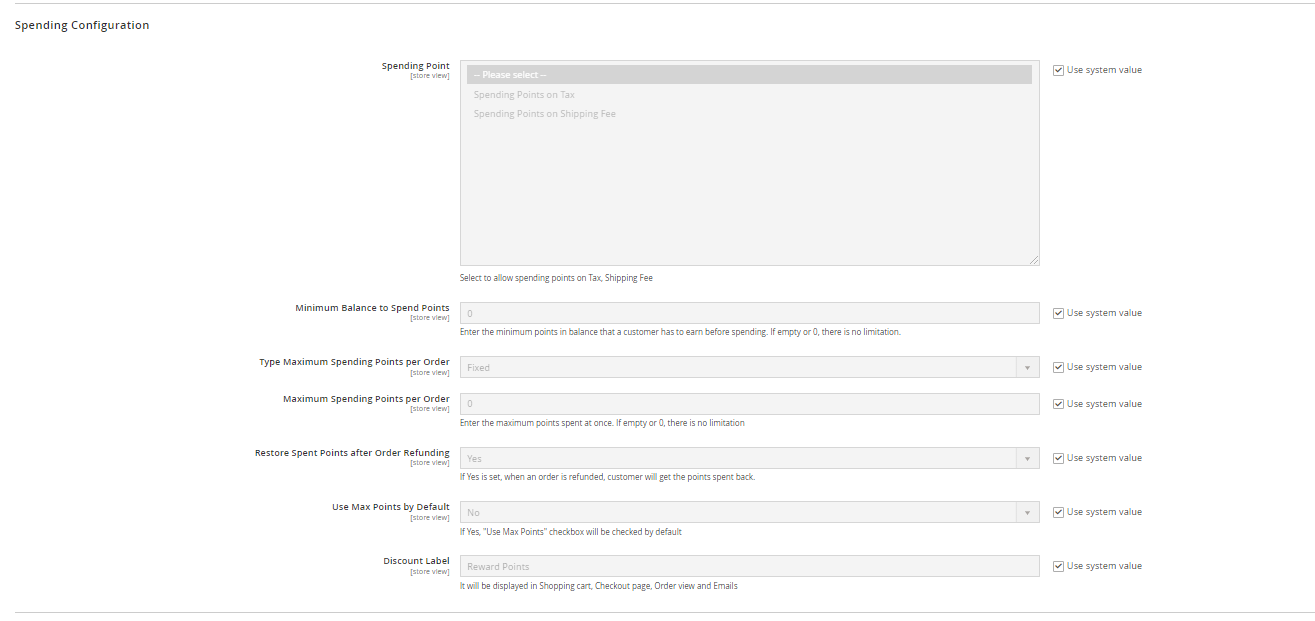
In the Spending Point field: there are 2 options:
- In the Points Spending From Tax: Choose “Yes” to enable customers to spend points to get discounted tax fee
- In the Spending Points on Shipping: Select “Yes” to allow customers to use their point(s) to reduce the shipping cost.
In the Minimum Balance to Spend Points field
- Set the minimum number of point(s) that customers must have in their balances as a condition to spend points on discounting orders.
- If the number of point(s) in the customer's balance is less than the minimum spending point, the Reward Points slider will not appear on the View Page or Checkout Page.
- If you leave it blank or 0, the default minimum point is 0.
In Type Maximum Spending Points per Order: Select how to set the maximum number of points allowed per order:
- Type Maximum Spending Points per Order = Fixed: the maximum number of points used for each order with a fixed value set in Maximum spending points per order field
- Type Maximum Spending Points per Order = Percent: the maximum number of points used for each order is set as a percentage of the total shopping cart value, set the maximum value in Maximum spending points per order field
In the Maximum spending points per order field:
- Set the maximum number of point(s) that customers can use on an order.
- If you leave it blank or 0, the maximum number of point(s) customers can spend is unlimited (it can be the maximum number of points they own or the maximum number of points which can be converted by SubTotal of Cart).
In the Restore spent points after order refunding field: When customers place an order, they can apply a certain amount of their reward point(s). Admins select “Yes” in this section to return point(s) to customers if their orders are refunded.
In the Use Max Point By Default field: Select “Yes” to set the customer's spending point(s) to the maximum number that they can use.
In the Discount Label field: Discount Label displayed on the frontend will change according to the content of this section.
4.4. Display Configuration.
The points displayed on the minicart are the points the customer will receive when placing an order to help the customer easily know how many points they will receive. This section also includes accumulated points on Top Link that help customers easily track their current points without having to go to another page to check. This makes customers' payment easier, faster and more convenient.

- In the Display Total Points on Top Links field: Select “Yes” to display the total number of reward point(s) that the customer has on Top Link.

- In the Display Earning Points on Minicart field: Select “Yes” to show the total number of earning point(s) customers can receive when checking out the cart at the Minicart page.

4.5. Email Configuration.
Admins can set up email notifications about changes in each customer's reward points as well as the expiration date of the reward points. This helps customers update their current reward points as well as the expiration date of the points. This can encourage customers to quickly use the points, promoting the purchasing process.

- In the Enable Notification Email field: Select “Yes” to allow notification emails to be sent to customers.
- In the Subscribe customers by default field: When a new customer subscribes to a store, receiving no emails is set as default. Select “Yes” in this section so that when their first transaction is made (by purchasing or by admin), Reward Points Notification will be checked immediately.
- In the Sender Email field: Admins can choose one of the 5 available Magento Senders: General Contact, Sales Representative, Customer Support, Customer Email 1, Customer Email 2
V. Manage Reward Point of Customer
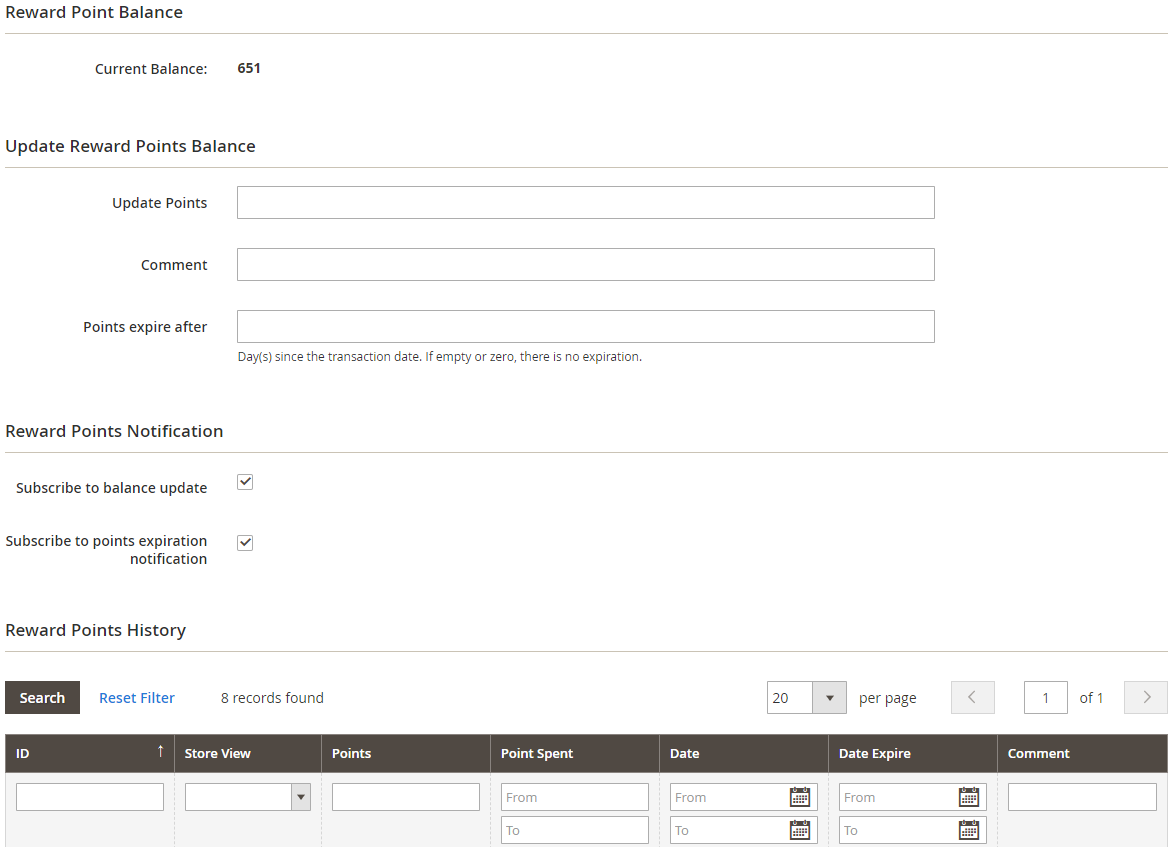
Admins can manage Reward Points Balance, Transactions and Notification of customers by going to Customer > Edit Customer > Reward Points.
- In the Reward Points Balance field: Indicates the total reward point(s) the customer has.
- In the Update Point Update Balance field: Allows admins to change the balance by filling in Update Point and set its expiration date. Admins can also enter the reason for the change in the Comment field
- In the Reward Points Notification field: Admins can register or cancel the subscribe on behalf of the customer when their balance is updated or point(s) is about to expire.
- In the Reward Points History grid: Displays information about all executed transactions: ID, Store View, Point, Point Spend, Date, Date Expired, Comment.
The information about Balance, Notification and Transaction in the backend will be synchronized with the customer's frontend at My Account > My Points & Reward.
VI. Refund Spent Point
With orders that can be applied reward points to get discount, when they are refunded, the points used before can be refunded by the store admin.

Click on the checkbox Refund Order to Points to refund points, the field Reward Point Refunded will be displayed
- Reward Point Refund: fill in the points refunded, this value must be smaller than the Spent Points used before for the order
VII. Customer Frontend.
7.1. My Account/My Points & Reward.
7.1.1. Reward Dashboard
Customers can check the Reward Point information in this section after logging in:
- Available Balance: Show current points of customer. This value equals Current Balance in the backend
- Total Earned: Show points that customer get from orders. This value quals Total Earning Points in the backend
- Total Spent: Show points used by customer. This value equals Total Spending Points in the backend
- Reward Information indicates
- Earning Rate and Spending Rate that customer is entitled (according to his Customer Group and Website set in the backend).
- The maximum number of points that the customer's balance can receive from orders.
- The maximum number of days that point(s) can be used since that customer receives point(s).
- At Recent Transaction: Customer can know the transaction history in detail
- Reason of transaction
- Number of point(s) changed
- Date and time of the transaction
- Expiration Dates of point(s)
- Transaction status
- They can also sign up to receive updates when their balance changes or point(s) is about to expire.
- All information here is synchronized in the backend
Customer > Reward Points
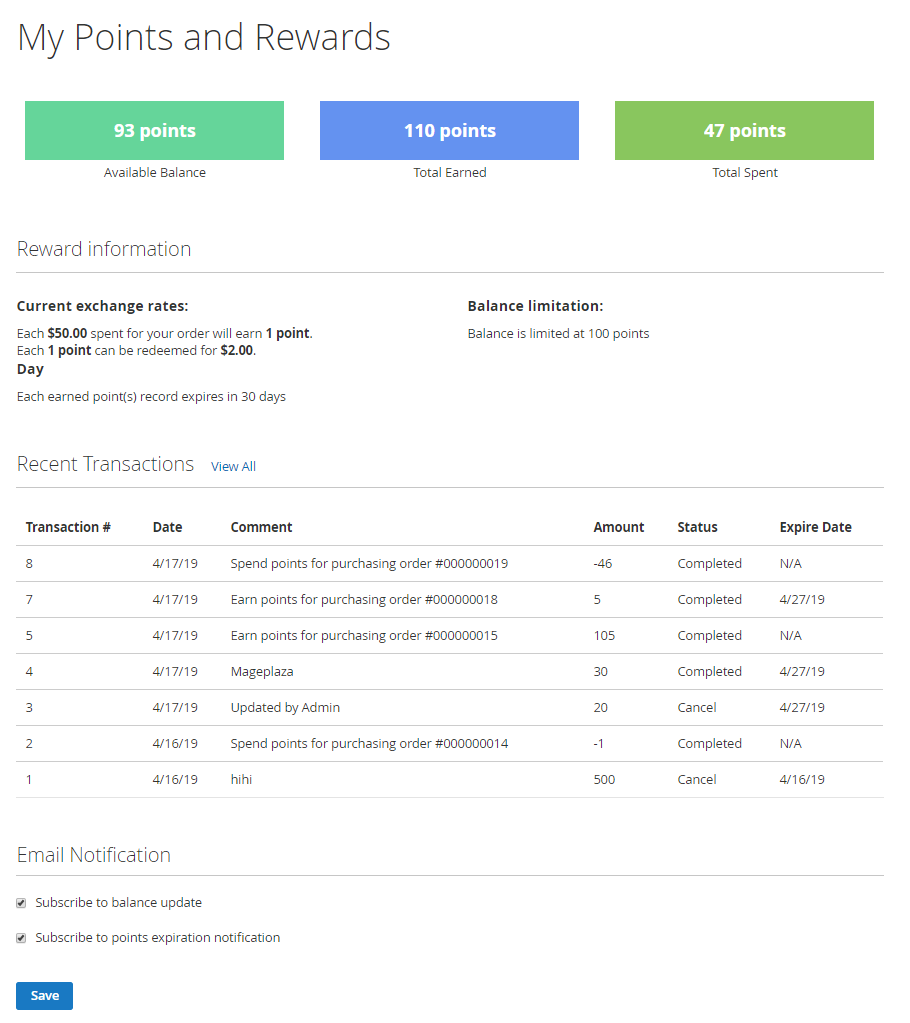
7.1.2
On the Transaction tab, all the rewarded transactions of customers are shown

7.2. Checkout Page
- Customers can use the slider or text box to select the amount of reward point(s) they want to spend.
- Used reward point(s) can be limited to a range.
- Customers are only allowed to use their point(s) within this range.
- If Subtotal has a value less than the minimum value of the limited value range, the Apply Reward Point section will not be displayed.
- Tick the checkbox Maximize my discount with Point to use all available points at once. The amount of points can be
- The total points that customer has if Total Point(s) < Max Point for per Order and Subtotal.
- Max Point if Max Point < Total Point and Subtotal.
- The number of point(s) which is equal to Subtotal if that amount < Max Point and Total Point.
- The Order Summary box will display more sections about reward points to make the calculation easier.
- Spending Point can be used for Tax, Shipping Fee if it’s configured in the backend.
- The conversion rate between Reward Point and Spending Point depends on the Spending Rate configuration in the backend.

7.3. Other additional frontends.
- Top link: Displays the point(s) that customer has.

- MiniCart: Displays the earning point(s) of all products in the cart.

- View Cart Page (Shopping Cart): Displays Apply Reward Point on the checkout page, and also displays the Earning Point, Spending Point and Reward Point.

VIII. REST API
Mageplaza Reward Points Standard supports using REST API to make requests related to Transaction, Customer's Reward account, Reward rate, get config reward information. Customers can use reward points for orders via Rest API.
View details of endpoints of Mageplaza Reward Points Professional here.
View REST API guidelines of Magento 2 here. Guidelines to create tokens here.
IX. GraphQL
9.1. How to install
Run the following command in Magento 2 root folder:
composer require mageplaza/module-reward-points-graphql
php bin/magento setup:upgrade
php bin/magento setup:static-content:deploy
Note: Magento 2 Reward Points GraphQL requires installing Mageplaza Reward Points in your Magento installation.
9.2. How to use
To perform GraphQL queries in Magento, please do the following requirements:
- Use Magento 2.3.x or higher. Set your site to developer mode
- Set GraphQL endpoint as
http://<magento2-server>/graphqlin url box (e.g. http://dev.site.com/graphql) - View details of queries supported by Mageplaza Reward Points GraphQL extension here
X: FAQs
XI. Support and Assistance
1. Customer Support
For any assistance, please visit our Support page or email us at cs@mageplaza.com/ sales@mageplaza.com
2. Create a Ticket
If you have technical issues, please open a ticket at this link.
Operating Hours
Our support team is available during the following hours:
- Monday to Friday: 8:00 AM - 23:59 PM
- Saturday: 8:00 AM - 12:00 PM
- Sunday: Closed
Refund Policy
We understand that sometimes things don't go as planned. Please review our refund policy for detailed information: Refund Policy Link
Frequently Asked Questions (FAQ)
For quick answers to common questions, please visit our FAQ page: FAQ Page Link